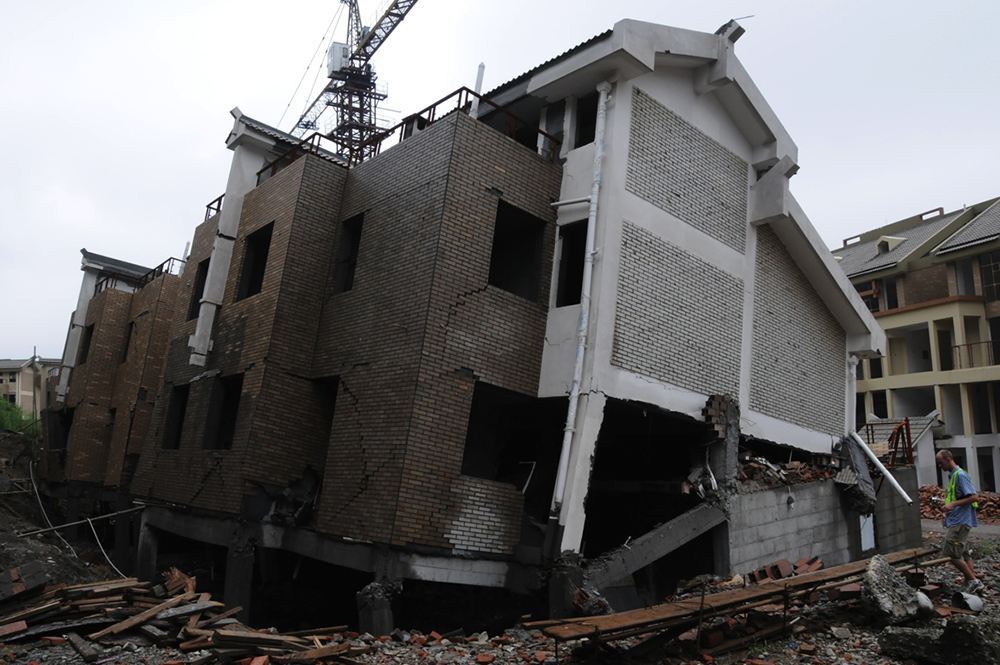Collapsed concrete building in China in 2008. (D. Swanson Photo)
Civil Engineering is engineering for society. Our profession is really all about people. In fact, we probably could retitle our profession “People Engineering.” One of the main tenets of our profession is to protect the public health, safety and welfare. Engineers are entrusted with some of our communities’ most important buildings: hospitals, police and fire facilities, schools, emergency operations shelters, office buildings and housing. Infrastructure, such as roads, bridges, treatment plants, dams and utilities, is vital to our communities.
When our communities are hit by earthquakes, floods, hurricanes, tsunamis, tornados, wildfire, etc., civil and structural engineers are essential to the response and recovery. Many engineering professionals who watch these events unfold on television wonder, “How we can help?” One way I have found to put our technical expertise to good use is to volunteer as a structural engineer for the Federal Emergency Management Agency’s (FEMA) Urban Search & Rescue (US&R) Task Force.
The Beginnings of Urban Search & Rescue in the United States
In the early 1980s, Fairfax County Fire & Rescue in Virginia and the Metro-Dade County Fire Department in Miami created elite search-and-rescue teams that trained for rescue operations in collapsed buildings. Deployed by the State Department and U.S. Agency for International Development (USAID), these teams provided vital search-and-rescue support for catastrophic earthquakes in Mexico City, the Philippines and Armenia.
David Hammond, a structural engineer from California who deployed to the 1985 Mexico City earthquake with his search dogs, realized that first responders to large-scale disasters would benefit from the capabilities and expertise of structural engineers who design buildings, bridges and infrastructure. Mexico City experienced vast devastation. Hundreds of buildings “pancaked,” or collapsed in progressive fashion, from the three-minute-long earthquake. Thousands of people were crushed from collapsed structures and hundreds were trapped in the void spaces within these collapsed buildings. David’s idea was to get those involved in the design of these facilities (structural engineers) to participate along with the first responders (police and fire) who are locating and rescuing victims from collapsed structures.
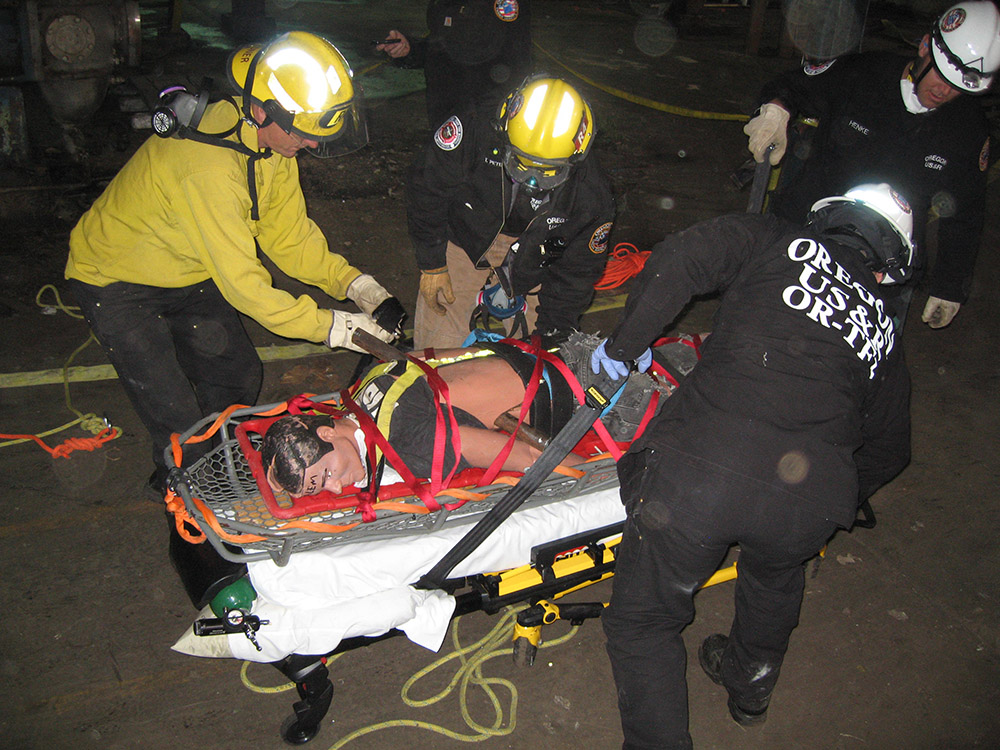
David witnessed the way first responders needed to gently take apart the collapsed buildings to rescue people trapped under tons of concrete and rubble and knew they could benefit from structural engineers’ knowledge of building construction. Additionally, structural engineers were needed to design emergency shoring for large buildings that were leaning or teetering on the verge of further collapse from aftershocks. David saw the devastation, and particularly the large collapsed buildings, in Mexico City as a large-scale structural engineering problem that structural engineers could readily help solve. Structural engineers bring a unique set of skills to the table. Our tool kit is portable; it is comprised of our brain, experience and knowledge. We understand how buildings and bridges are constructed, we know how to shore damaged buildings, and our technical training allows us to have an intimate knowledge of the behavior of structures and materials in extreme events.
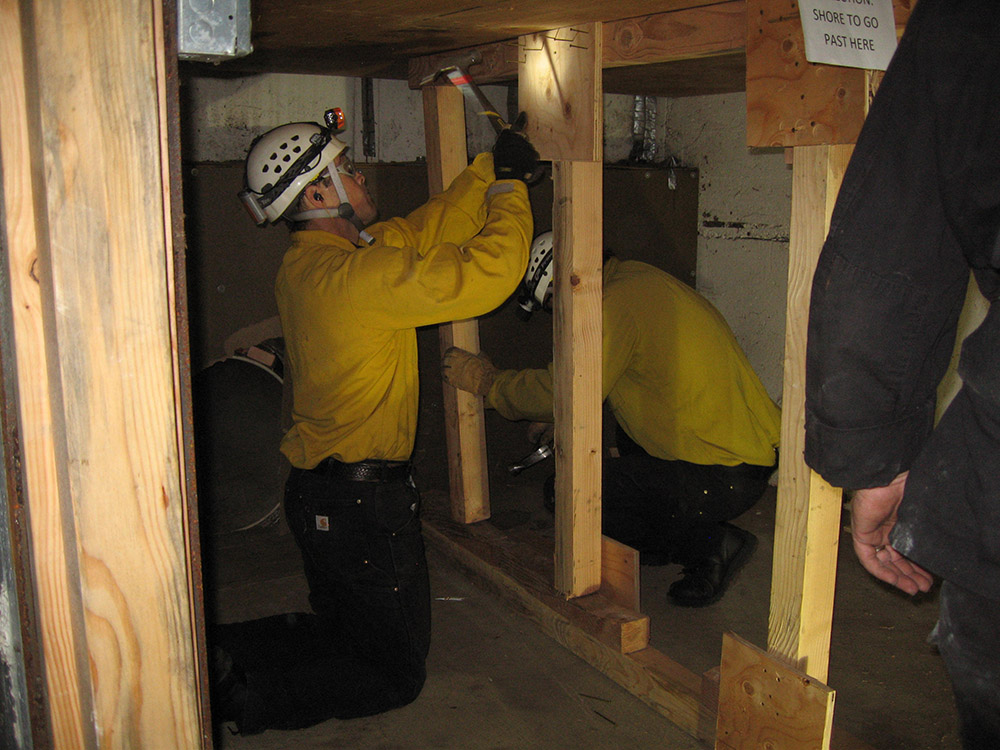
In 1989, FEMA established the National Urban Search and Rescue Response System as framework for structuring local emergency services personnel into integrated federal-level disaster response task forces. In 1991, FEMA sponsored 25 national urban search-and-rescue task forces, one of which is the Washington State Task Force 1 (WA TF-1).
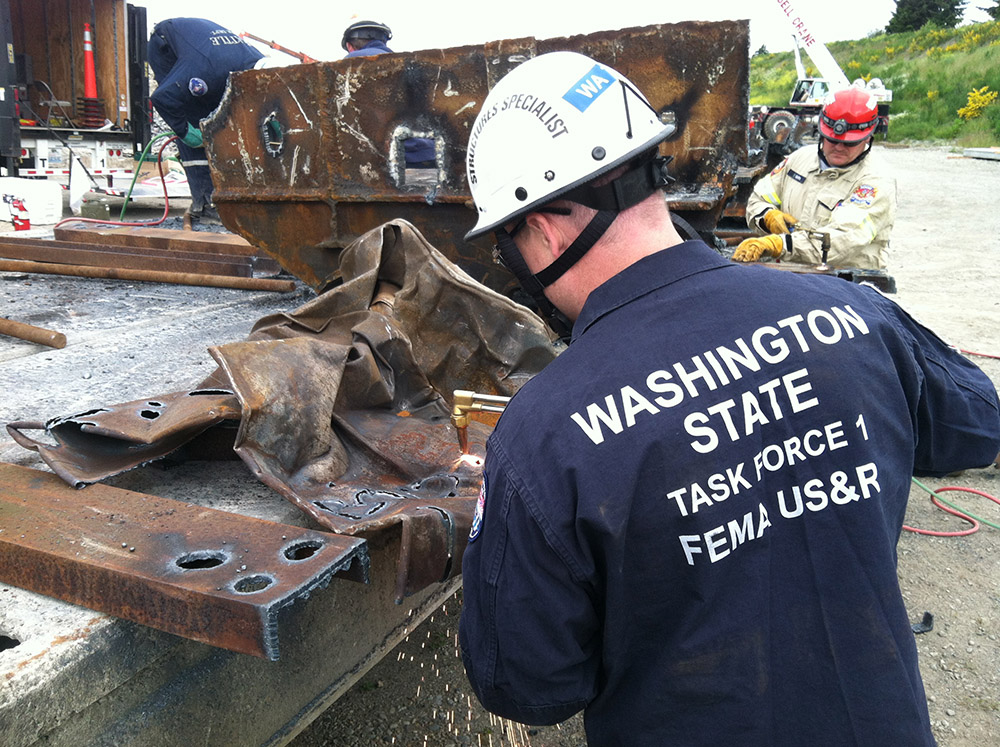
How I Got Involved
When I was a young graduate engineer interested in earthquake engineering, I read an article in ASCE News calling for engineers to participate on the newly formed FEMA US&R Task Forces. I was intrigued about the opportunity to participate in these efforts, so I sent a letter to David Hammond. David referred me to the Pierce County Department of Emergency Management (DEM), the lead agency in my area. At this time, FEMA was organizing 25 task forces to be strategically located around the United States. The Pacific Northwest and Alaska was to be served by the new FEMA US&R WA TF-1 team.
I submitted my application to Pierce County DEM and started attending volunteer training. Initial training sessions consisted of awareness-level training sessions on the Incident Command System, Hazardous Materials, Search and Rescue Techniques, Rope Rescue and Shoring. Training was done during evenings and weekends for the volunteers. Expert first responders from the Puget Sound area taught these classes to engineers and other civilian volunteers that ranged from doctors to search dog handlers. This initial training was an eye opener for me as a young engineer about the difficult job that our first responders have in disaster situations and the hierarchical command and control team-oriented environment in which they operate.
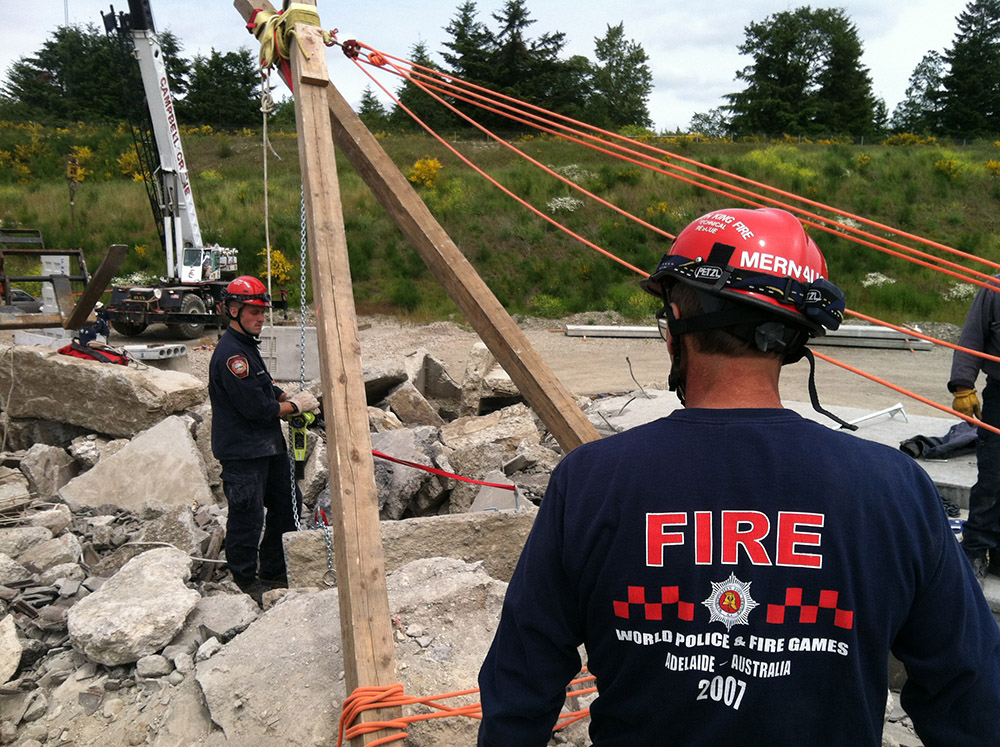
FEMA US&R Task Force Deployments
Early deployments of FEMA US&R Task Forces included response to the 1994 Northridge Earthquake on Los Angeles in 1994, the 1995 bombing of the Murrah Federal Building in Oklahoma City, the 1998 grain elevator explosion in Kansas and earthquakes in Turkey and Greece in 1999. These events underscored the need for these highly skilled teams to rescue trapped victims. The collapse of the World Trade Center and portions of the Pentagon from the terrorist attacks on September 11, 2001, and the high profile nature of the FEMA US&R deployments to these events, galvanized our national commitment to FEMA’s US&R Program.
Today, there are 28 national FEMA US&R task forces staffed and equipped to conduct round-the-clock search-and-rescue operations following earthquakes, tornadoes, floods, hurricanes, aircraft accidents, hazardous materials spills and catastrophic structure collapses. These US&R task forces, complete with necessary tools and equipment and required skills and techniques, can be deployed by FEMA for the rescue of victims of structural collapse. Past deployments include:
- 2001 World Trade Center and Pentagon Disaster
- 2002 Olympic Games in Salt Lake City, Utah
- 2005 Hurricane Katrina
- 2006 Hurricane Ernesto
- 2007 Greenburg Kansas Tornado
- 2008 Hurricane Ike and Gustav
- 2010 Haiti Earthquake
- 2011 Christchurch New Zealand Earthquake
- 2011 Great East Japan (Tohoku) Earthquake
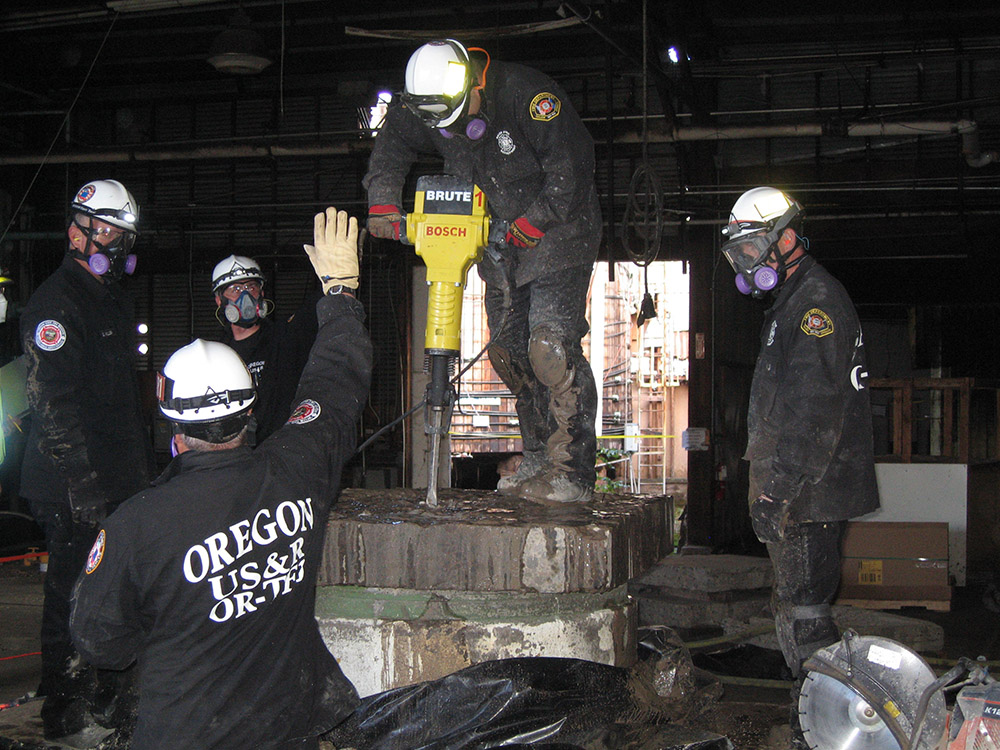
FEMA US&R Task Force Team Makeup
If a disaster warrants national US&R support, FEMA will deploy the three closest task forces within six hours of notification and additional teams as necessary. The role of these task forces is to support state and local emergency responders’ efforts to locate victims and manage recovery operations. FEMA US&R Task Force consists of two 31-person teams that work in two 12-hour shifts, around the clock. These teams include four search dogs and a comprehensive equipment cache. FEMA US&R Task Force members work in four areas of specialization:
- Search: Specialists to find victims trapped after a disaster.
- Rescue: Specialists who perform extrication of victims. This includes safely digging victims out of tons of collapsed concrete and metal.
- Technical: This specialization is made up of structural engineers who make rescues safe for the rescuers and victims.
- Medical: This specialty cares for the victims before and after a rescue.
Failure Teaches Us about Good Design
Designing structures to better withstand the effects of extreme events like earthquakes, tsunamis, hurricanes and bomb blasts require that we pay attention to how our designs perform in these extreme events. Using this knowledge and our technical engineering training to help a rescue team access a collapsed building in as safe a manner as possible is one of the many ways structural engineers can help first responders with their work. As population and human development grow in areas of high hazards, the need for rescue and response/recovery engineering by civil and structural engineers will also grow. I firmly believe that rescue engineering and volunteer participation by engineers on US&R teams and other humanitarian activities will become a more prominent avenue for civil and structural engineers to lend their expertise to help our communities be more resilient to the effects of catastrophe. The “people engineering” aspect of volunteering our expertise for Urban Search & Rescue as well as other humanitarian activities offers a level of deep satisfaction in our profession that is hard to duplicate.

